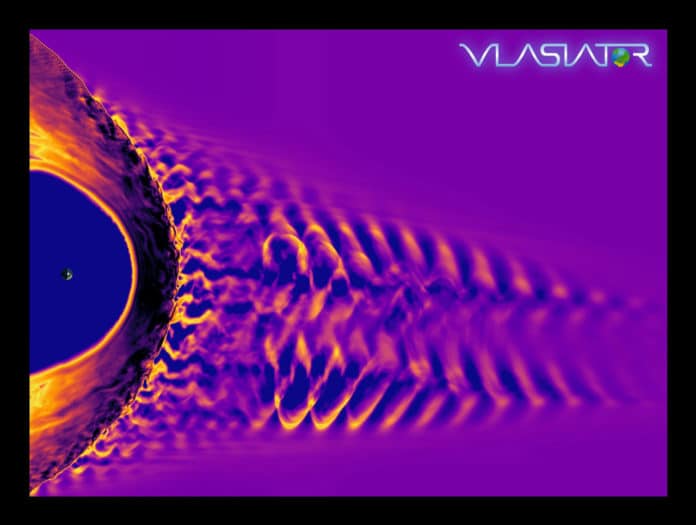Solar storms are giant clouds of particles ejected from the Sun into space during solar eruptions. When solar storms are directed toward Earth, they can cause enormous disturbances in near‐Earth space, for instance, disturbing communications or damaging space shuttles. Understanding in detail what happens when solar storms arrive at Earth is essential to relieve their effects.
In a new study, scientists used measurements from the Cluster spacecraft to investigate how solar storms modify the properties of the very first region of near‐Earth space they encounter when journeying toward Earth. The data provided a recording of Earth’s magnetic field.
Scientists just released a recording of the eerie “song” that Earth sings when a solar storm hits it. The song originates from waves that are generated in the Earth’s magnetic field by the collision of the storm.
The Cluster consists of four spacecraft that orbit Earth in formation, investigating our planet’s magnetic environment and its interaction with the solar wind. As part of their orbits, the Cluster spacecraft repeatedly fly through the foreshock, which is the first region that particles encounter when a solar storm hits our planet.
In this latest analysis, scientists found that- during the collision, the foreshock tends to release magnetic waves that are incredibly complex. This suggests that solar storms profoundly modify the foreshock region.
Scientists transformed the frequencies of these magnetic waves into audible signals, they got an uncanny song that might recall more the sound effects of a science fiction movie than a natural phenomenon.
Scientists also found that the song is lower in pitch and less complex, with one single frequency dominating the oscillation- when no solar storm is striking the Earth. When the solar storm hits the Earth, the frequency rises- with the precise frequency of the resulting waves being dependent on the strength of the magnetic field in the storm.
Not only does the frequency of the wave change, but it also becomes much more complicated than the single frequency present in quiet times.
The changes in the foreshock can affect how the solar storm is propagated down to the Earth’s surface. However, the functioning of this process remains a mystery. Yet, it is clear that the energy created by waves in the foreshock can’t escape back into space, as the waves are pushed towards Earth by the solar storm.
Before they arrive at our environment, in any case, the waves encounter another hindrance, the bow shock, which is the magnetic region of space that hinders solar wind breeze particles before they collide into Earth’s magnetic field. The collision of the magnetic waves modifies the behavior of the bow shock, perhaps changing how it processes the energy of the incoming solar storm.
Behind the bow shock, the magnetic fields of Earth start to resonate at the frequency of the waves, and this contributes to transmit the magnetic disturbance to the ground. It is a fast process, taking around ten minutes from the wave being generated at the foreshock to its energy reaching the ground.
Scientists are now putting their efforts into understanding how these complex waves are generated.
Lucile Turc, a former ESA research fellow who is now based at the University of Helsinki, Finland, said, “We always expected a change in frequency but not the level of complexity in the wave.”
“This new scientific study based on the long-lived Cluster mission provides another detail in that knowledge, but it also has a larger role to play in our understanding of the universe. Magnetic fields are ubiquitous, and so the kind of complex interaction seen in Earth’s foreshock may take place in a variety of cosmic environments, including exoplanets orbiting close to their parent star, as they would be immersed in intense magnetic fields.”
Philippe Escoubet, ESA Project Scientist for Cluster, said, “This is an excellent example of how Cluster continues to extend our knowledge of the sun-Earth connection, even years after the original data was obtained.”
“The results take us deeper into the details of fundamental magnetic interactions that take place across the universe.”
The study is reported in the journal Geophysical Research Letters.
